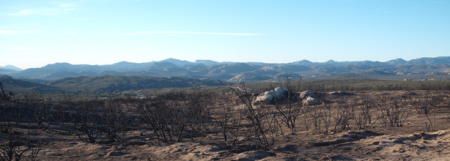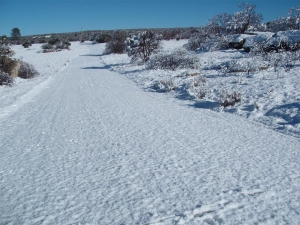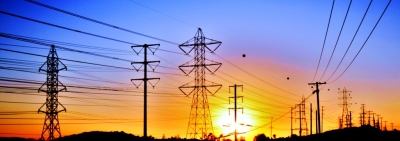Federal comment period now open for Enviornmental Impact Statement;
SDG&E also seeks approval for power lines tied to project without environmental review or public hearing

By Miriam Raftery
January 14, 2013 (Campo) – The Campo Indian tribe has proposed to lease a portion of its reservation to Invenergy LLC for an industrial energy project, Shu-luuk Wind. The project would include 85 wind turbines, each approximately 500 feet tall, on tribal lands near the rural communities of Campo and Boulevard. The project study area of impact spans over 4,700 acres; the developer claims a project footprint of 900 acres; many new miles of roads and power lines are also proposed.
The Draft Enviornmental Impact Statement has been published in the federal register at http://www.gpo.gov/fdsys/pkg/FR-2013-01-11/html/2013-00439.htm. Comments may be submitted to SHuluukcomments@aecom.com and must be received by February 25. All project documents are available at www.shuluukwind.com. View a map of proposed project here.
Two hearings on the Shu’luuk project will be held by the Bureau of Indian Affairs on January 29 and 30 from 6 to 9 p.m. The January 29 hearing will be at the Alpine Community Center, 1830 Alpine Blvd. in Alpine. The January 30 hearing will be at the Campo Indian Reservation Tribal Hall, 36190 Church Road in Campo. View hearing notice.
Shu’luuk wind advocates claim the project could produce up to 250 MW of power to help meet the state’s renewable energy goals, also providing revenue for the Campo tribe. But neighbors and planners in nearby communities are voicing serious concerns about the impacts of the project on their rural neighborhoods.
“This is another nightmare project,” Donna Tisdale, chair of the Boulevard Community Planning Group, said of Shu’luuk Wind. Boulevard, where zoning formerly limited homes to one per 80 acres, has recently been designated an “energy corridor” by the federal government, as ECM recently reported. Several major wind energy facilities as well as multiple industrial solar projects are proposed to surround rural homes here.
Some residents already claim negative health impacts from existing wind turbines on the Campo tribe’s Kumeyaay wind facility. These include members of the Manzanita tribe, whose land abuts Campo’s. Plagued with cancer and other ailments, Manzanita tribal members have been admitted into a university health study after stray voltage at levels 1,000 times higher than normal were measured in their tribal hall, church, and homes.
Non-tribal members are also impacted. In a letter to the Bureau of Indian Affairs Superintendent Robert Eben, Boulevard resident Don Bonfiglio said he prays Shu'luuk wind will not be approved. He lives three miles from the existing turbines and says the noise and vibrations keep him awake at night. "Four out of seven days a week it sounds like helicopters are hovering over my house at 500 feet," he wrote in a 2011 letter. "This is a constant "hum" that doesn't go away, day and night... What can you do for us? What will you do to help relieve our suffering?"
Bonfiglio also states that while visiting the Campo Wind Farm he witnessed a golf cart filled with over a dozen large dead birds. "One of the birds was the largest Horned Owl I have ever seen," he wrote. "Who keeps track of the type and number of birds killed or maimed by these giant turbines? What an unnecessary tragedy!" The BIA has in the past refused to provide data on bird kills at the Campo wind facility.
The proposed project would also require a new 138 kV line. The draft EIS claims that the project brings not only economic, but environmental benefits to the community through renewable energy. But many residents see this as environmental destruction, not salvation.
Melody Ponchot leases a ranch in Boulevard near Tisdale’s. She is also secretary of the Boulevard Planning Group.
 “Wind turbines will be placed a meager 500 feet from Donna’s and my ranches,” she said, sending photos to show the areas that will be impacted if the project is approved by the Bureau of Indian Affairs.
“Wind turbines will be placed a meager 500 feet from Donna’s and my ranches,” she said, sending photos to show the areas that will be impacted if the project is approved by the Bureau of Indian Affairs.
One image (cover photo, top) shows present views of Mounts Laguna, Cuyamaca, Guatay, Corte Madera, Los Pinos and Lyons peak – all of which would be dwarfted by turbines if the project is built. Others show pristine views of snow-covered or boulder-strewn terrain.
“This would be insane to have such huge monsters; as you can see this would completely destroy our views and bring health problems for sure,” Ponchot wrote, adding that there are many more homes and ranches close enough to be negatively impacted.
In addition, some residents fear the distraction of 85 blinking red lights going on and off every few seconds all night long, as required by the Federal Aviation Administration to prevent aircraft from striking the towering turbines.
“It’s terrifying to think they could be this close in two directions,” said Ponchot, who ironically moved away from her former residence near the Kumeyaay wind farm because of health problems she believes were caused by the turbines there. “It is our Heaven, and Heaven gets a prayer from me on this fight a couple times a day lately,” she said, adding that she prays for God to “give us all the strength to save the East County from being raped of its natural wonders.”
 Tying into the Shu’luuk Wind project, SDG&E seeks to build a Wind Interconnection without holding public hearings and bypassing key environmental reviews. Public comments may be submitted to the California Public Utilities Commission at public.advisor@cpuc.ca.gov.
Tying into the Shu’luuk Wind project, SDG&E seeks to build a Wind Interconnection without holding public hearings and bypassing key environmental reviews. Public comments may be submitted to the California Public Utilities Commission at public.advisor@cpuc.ca.gov.
In a letter to California Public Utilities Commissioner Michael Peevey, Supervisor Dianne Jacob has objected to SDGY&E’s lack of public hearings and request for an ex-parte approval of the permit for its Wind Interconnection project.
“Since the community of Boulevard is subjected to a high degree of industrial conversion, public hearings are paramount in order to fully consider the impacts to public health, fire safety, property values and fire insurance rates in our community,” Supervisor Jacob wrote.
In addition, she noted that under the California Environmental Quality Act (CEQA), Boulevard qualifies as a disproportionately impacted low-income Environmental Justice community. “The existing 50 MW Kumeyaay Wind project already generates complaints about noise, infrasound, and electrical pollution within a 3-mile radius,” she wrote. “An additional 883 MW of wind and solar projects are being proposed and the community deserves a full, open and honest review.”
Jacob voiced particular concern about wildfire risk, noting, “In an area already designated as a very high fire hazard zone, the increased number of turbines, solar panels and flammable fluids significantly increase the threat of catastrophic wildfire ignition. This increased risk, paired with limited fire fighting capabilities, poses a severe threat to the community.”
Last summer, the Shockey Fire charred 2500 acres, burned numerous homes and outbuildings, and took the life of an elderly man. These losses occurred at a time when no other wildfires were burning in the region and winds were only low to moderate speed, supporting Jacob’s contention that firefighting capabilities are already spread too thin to assure protection for Boulevard residents, even without adding thousands of acres of new potential ignition sources.
The Boulevard Planning Group also voiced opposition to the SDG&E Wind Interconnection project. In a letter sent to Supervisor Jacob and CPUC commissioners, Tisdale and the Planning Group called for a full EIR and public hearing. The letter also requests that an updated review on electromagnetic frequency (EMF) guidelines be conducted to asses emerging adverse health impacts related to “increased and unsafe levels of electrical pollution that can be generated by industrial scale energy and transmission projects…including increased ground currents, radiation, and electromagnetic interference,” adding that prelimnary testing shows unsafe levels in and around homes.
Tisdale also wants scientifically valid investigations into the cumulative adverse impacts of multiple energy projects, including substations and neutral ground wires, to determine impacts and potential mitigation options.
“We have a right to equal protection under the law,” Tisdale writes, noting that the Attorney General in California has interpreted CEQ to include environmental justice requirements. “Increased risk of fire and adverse impacts to groundwater resources, to our families, pets, livestock, wildlife, property values, sense of place, and enjoyment of our properties are other key areas of concern,” Boulevard’s Planning Group letter concludes.







Comments
Wind energy is toxic
How much community support would there be for this industry if the wind industry did not lie about turbine impacts, lie about energy output/potential, and stopped their false promotion of turbines being a solution to our energy needs? There would be very little support and that day is coming.
But even if a person doesn't understand that these wind projects will always be a small supplement to the grid and that rare bird species are being slaughtered off across the world, everyone should be concerned about a few private landowners selling out the quality of life in communities. It happens everywhere these turbines go up. Serenity is lost and property values plummet. There is something very wrong when a landowner or is allowed to profit off this degradation.
Ignorance, fraud, and obscene profits are keeping this industry alive. Why have over 200 whooping cranes gone missing in the last several years? Why do investors like Google have to give $2.65 million to wind energy lobbying groups? We all know why.
The wind industry is rapidly losing friends. That is why a major resistance movement towards wind is developing across the world. People are realizing wind turbines are toxic.
On a recent hike near "El
On a recent hike near "El Capitan"--aka, El Cajon mountain--I passed a free-standing National Forest Service placard that described the area's crucial importance as a nesting site for several threatened raptors, including the majestic Golden Eagle. Visitors, it stressed, needed to remain aware of this fact and treat the area with the utmost respect.
But, of course, none of this applies to president Obama, or his secretary of the interior Ken Salazar, who've exempted both themselves and their wind industry partners from any legal liability for for killing tens of thousands of these rare and precious animals.
Wind turbines are, as everyone knows, virtual "bird blenders." So, in addition to being a preposterously inadequate answer to our growing energy needs and industrializing hundreds of thousands of once open, wilderness land, they also stand a good chance of putting many birds-of -prey back on the endangered species list.
But, hey!--for being politically cool--"progressive"--no price is too great to pay, right?